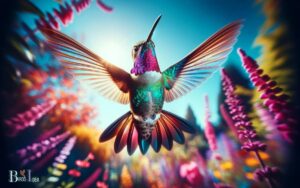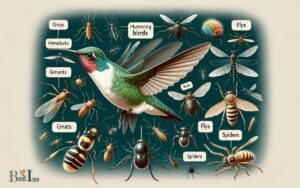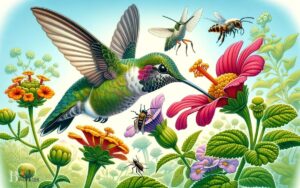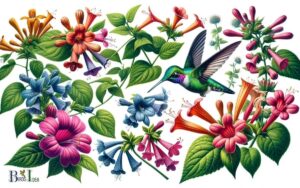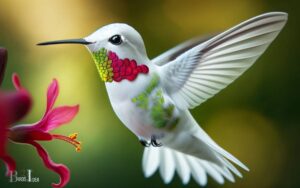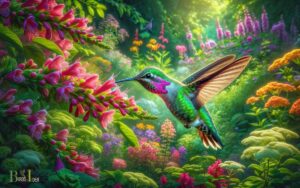Anna’s Hummingbird Favorite Flower: Salvia, Penstemon!
The Anna’s Hummingbird (Calypte anna) is particularly attracted to flowers with high nectar content, such as the salvia, penstemon, and fuchsia.
However, among its favorites is the California fuchsia (Epilobium canum), which not only provides a rich nectar source but also blooms at a time when other sources are scarce.
Anna’s Hummingbirds have a preference for flowers that are tubular and brightly colored, typically in shades of red, orange, or pink, as these are easy for the birds to access and often indicate a high nectar content.
The flowers they frequent include:
These flowers not only offer abundant nectar but also have the right shape to accommodate the hummingbird’s long beak and tongue, allowing for an efficient feeding process.
The birds are essential for the pollination of these plants, as they transfer pollen from flower to flower while feeding.
The symbiotic relationship between Anna’s Hummingbirds and flowers like the California fuchsia showcases the intricate balance within ecosystems, where each species plays a critical role.
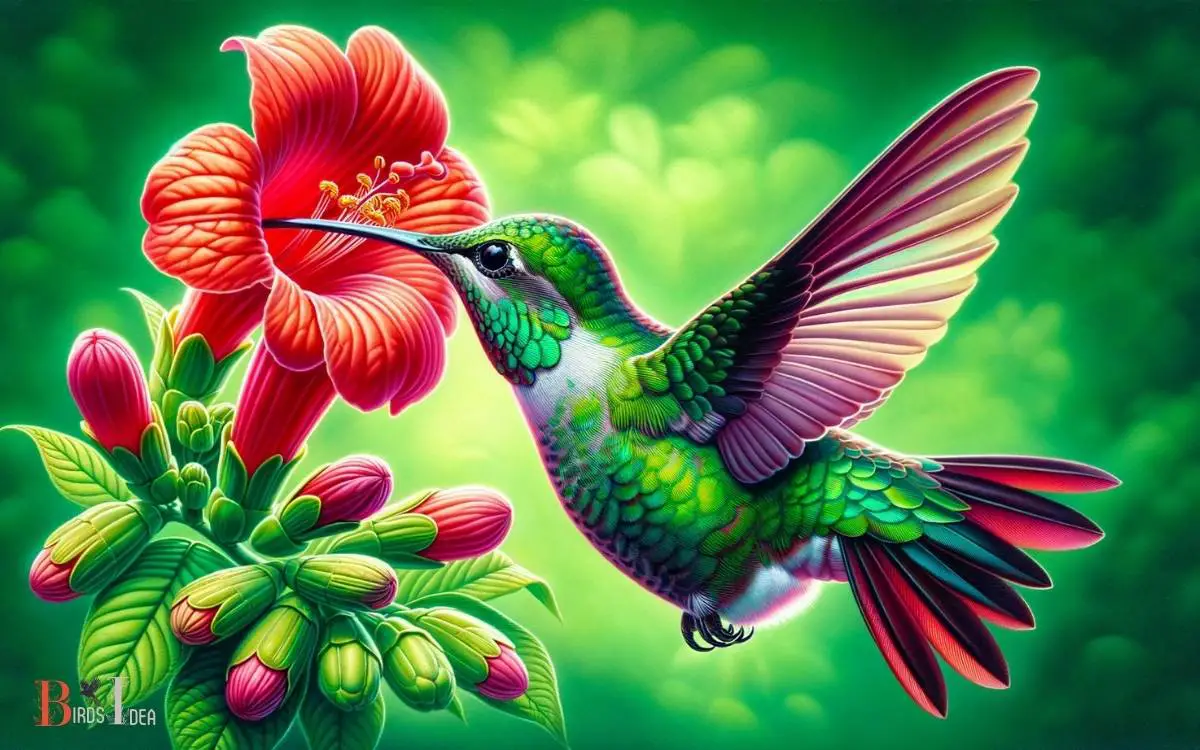
Key Takeaway
The Fascinating Anna’s Hummingbird
The behavior and characteristics of the Anna’s Hummingbird have long fascinated ornithologists and nature enthusiasts alike.
This species, native to the western coast of North America, is known for its stunning iridescent plumage and impressive aerial acrobatics.
The male Anna’s Hummingbird is adorned with vibrant rose-pink feathers on its head and throat, which shimmer in the sunlight. Its courtship displays involve rapid, elaborate dives and high-speed chases to attract a mate.
In terms of behavior, this species is highly territorial and will aggressively defend its feeding and nesting areas against intruders, often engaging in intense aerial battles.
Additionally, Anna’s Hummingbirds have a remarkable ability to enter a state of torpor during cold nights to conserve energy, lowering their metabolic rate to survive until the next day.
The Importance of Fuchsia Flowers
An essential component of the Anna’s Hummingbird’s diet is the nectar of fuchsia flowers, which provides them with crucial nutrients and energy for their daily activities.
The fuchsia flowers are particularly important as a food source for Anna’s Hummingbirds due to their high energy content and abundance of sucrose, which is a primary energy source for these small birds.
The nectar of fuchsia flowers also contains essential amino acids and vitamins, which contribute to the hummingbird’s overall health and vitality.
The vibrant color of fuchsia flowers attracts the attention of hummingbirds, making them a significant source of sustenance.
The availability of fuchsia flowers can significantly impact the presence and behavior of Anna’s Hummingbirds within their habitat, shaping their foraging patterns and breeding success.
Characteristics of Anna’s Hummingbirds
Anna’s hummingbirds are known for their unique mating displays, which often involve aerial acrobatics and rapid dives. They are also highly territorial, fiercely defending their feeding and nesting areas from other birds and even larger animals.
Additionally, these hummingbirds produce distinctive calls that are used for communication and to establish dominance within their territory.
Unique Mating Displays
One of the most remarkable aspects of Anna’s Hummingbirds is their intricate and mesmerizing mating displays.
The male Anna’s Hummingbird performs elaborate aerial displays to attract a mate. These displays involve steep dives, followed by a rapid ascent while producing a high-pitched sound with their tail feathers.
The male Anna’s Hummingbird’s iridescent throat patch, or gorget, plays a crucial role in these displays, flashing bright pink and red hues as they move, creating a captivating visual effect.
The females, on the other hand, carefully observe these displays and make their selection based on the male’s performance.
These unique mating displays are not only visually stunning but also a testament to the remarkable evolutionary adaptations of Anna’s Hummingbirds in their pursuit of reproductive success.
Territorial Behavior and Calls
During the breeding season, Anna’s Hummingbirds fiercely defend their territories and emit distinctive calls to assert their presence and deter intruders.
These tiny birds are highly territorial, often choosing perches with good visibility to watch over their territory.
The male’s display of territorial behavior includes aerial displays, where they ascend to great heights before diving rapidly, emitting sharp metallic calls during the display.
These calls, known as “squeaks,” are distinct to Anna’s Hummingbirds and serve as a warning to intruders.
The territorial behavior of Anna’s Hummingbirds also includes aggressive chases and physical confrontations with other hummingbirds entering their territory.
Understanding these territorial behaviors and calls provides insight into the complex social dynamics and survival strategies of Anna’s Hummingbirds during the breeding season.
Fuchsia Flowers: A Vital Food Source
Fuchsia flowers are a vital food source for Anna’s Hummingbirds due to their high nectar production and unique tubular shape, which accommodates the hummingbird’s long, specialized beak.
The vibrant coloration and abundance of fuchsia flowers in certain regions make them a preferred feeding source for Anna’s Hummingbirds, contributing significantly to their foraging behavior and overall energy intake.
The nectar found within fuchsia flowers contains essential nutrients that sustain the hummingbird’s high metabolic rate, making it a crucial component of their diet.
Hummingbird Fuchsia Preference
Hummingbirds exhibit a strong preference for fuchsia flowers as a vital food source throughout the year.
The tubular shape of fuchsia flowers perfectly complements the hummingbird’s long, specialized beak, allowing them to access the nectar hidden within.
Fuchsia flowers produce a copious amount of nectar, providing the high energy content that hummingbirds require for their active lifestyle.
The bright, vivid colors of fuchsia flowers, particularly reds and pinks, attract hummingbirds from a distance, serving as an essential visual cue for locating food sources.
Additionally, the blooming period of fuchsia flowers coincides with the breeding season of hummingbirds, making them an indispensable food source for rearing offspring.
The abundance of fuchsia flowers in various habitats further contributes to their significance as a preferred food source for hummingbirds.
Fuchsia Flower Nectar
A significant aspect of the fuchsia flower’s appeal lies in the copious nectar it produces, making it an essential food source for many bird species. The nectar of fuchsia flowers is characterized by its high energy content, attracting a wide variety of nectar-feeding birds.
This nectar is rich in sucrose, glucose, and fructose, providing a quick source of energy for the avian foragers.
Fuchsia flowers produce nectar with a unique chemical composition that is specifically tailored to attract and nourish birds, ensuring their effective pollination.
The shape and orientation of the fuchsia flower petals are adapted to facilitate access to the nectar for specific bird species, including hummingbirds and sunbirds. This adaptation enhances the flower’s attractiveness to these nectar-feeding birds.
The fuchsia flower’s abundant nectar serves as a vital food source for various bird species, including the Anna’s hummingbird, influencing their foraging behavior and habitat preferences.
Anna’s Hummingbird’s Foraging Behavior
Anna’s Hummingbird’s foraging behavior is influenced by a variety of factors, including flower availability, nectar quality, and competition with other hummingbirds.
These birds are known to favor flowers with high energy content nectar, such as those found in fuchsia and sage, and they often display territorial behavior around these food sources.
Their foraging patterns are also influenced by the time of day, with peak foraging occurring during the morning and late afternoon.
Additionally, Anna’s Hummingbirds have been observed to select flowers based on the ease of access to nectar and the presence of perches for resting between feeding bouts.
Understanding these behaviors is crucial for creating a suitable environment to attract these birds to your garden.
Attracting Anna’s Hummingbirds to Your Garden
Attracting Anna’s Hummingbirds to your garden requires providing the right combination of flowers and perching spots, in order to create an environment that meets their foraging preferences and territorial behaviors.
- Native Plants: Incorporate native flowers such as California fuchsia, desert willow, and salvia to attract Anna’s Hummingbirds.
- Tubular Flowers: Plant tubular flowers like penstemon, columbine, and honeysuckle to provide a nectar source for the hummingbirds.
- Colorful Blooms: Include brightly colored flowers such as red, orange, and pink as these hues are known to attract hummingbirds.
- Perching Spots: Install perches or small branches where the birds can rest and survey their surroundings.
- Continuous Bloom: Select flowers that bloom at different times throughout the year to ensure a consistent nectar supply for the hummingbirds.
Fuchsia’s Role in Ecosystem Preservation
The fuchsia plant plays a crucial role in ecosystem preservation due to its ability to attract and provide sustenance for various pollinators and wildlife.
Fuchsia’s tubular flowers are specifically adapted to attract pollinators like hummingbirds, bees, and butterflies.
These pollinators play a vital role in the maintenance of plant biodiversity and ecosystem health.
The nectar produced by fuchsia flowers serves as a food source for these pollinators, aiding in their survival and contributing to the overall health of the ecosystem.
In addition to attracting pollinators, the dense foliage of fuchsia provides shelter and nesting sites for small birds and insects.
This further enhances the biodiversity within the ecosystem, making fuchsia an important plant for ecosystem preservation and conservation efforts.
Nectar-filled Blooms and Hummingbird Health
Nectar-filled blooms provide essential sustenance for the health and well-being of Anna’s hummingbirds.
These tiny birds rely on the nectar from flowers as their primary energy source and for meeting their nutritional needs. The relationship between nectar-filled blooms and hummingbird health is crucial and fascinating.
Here are some key observations:
- Nectar is a vital source of energy, providing the necessary calories for hummingbirds to fuel their high metabolic rates.
- The consumption of nectar also supplies essential nutrients such as amino acids, vitamins, and minerals required for hummingbird health.
- The act of feeding on nectar-rich blooms supports the hummingbirds’ hydration needs, especially in arid environments.
- The interaction with nectar-filled blooms encourages pollination, benefiting the overall health of the local ecosystem.
- The availability of diverse nectar-filled blooms supports hummingbirds’ health by providing a varied diet, contributing to their overall well-being.
Conservation Efforts for Fuchsia Plants
Conservation efforts for fuchsia plants are vital for preserving the essential nectar source that sustains Anna’s hummingbirds.
Fuchsia plants, specifically Fuchsia magellanica, are a crucial food source for these hummingbirds due to their high nectar production and long blooming period.
However, habitat loss, climate change, and invasive species pose significant threats to fuchsia populations.
Conservation initiatives such as habitat restoration, invasive species management, and public awareness campaigns are essential for the protection of fuchsia plants.
Additionally, botanical gardens and arboreta play a key role in conserving fuchsia species through ex-situ conservation programs.
Collaborative efforts among researchers, conservationists, and local communities are imperative for the long-term survival of fuchsia plants and the preservation of crucial nectar sources for Anna’s hummingbirds.
Conclusion
The Anna’s Hummingbird demonstrates a strong preference for the nectar-rich fuchsia flowers, which play a vital role in their foraging behavior and overall health.
The mutualistic relationship between the hummingbirds and fuchsia plants highlights the importance of preserving these ecosystems.
By understanding the significance of fuchsia flowers in sustaining Anna’s Hummingbird populations, conservation efforts can be directed towards protecting these essential food sources for the benefit of both species.

